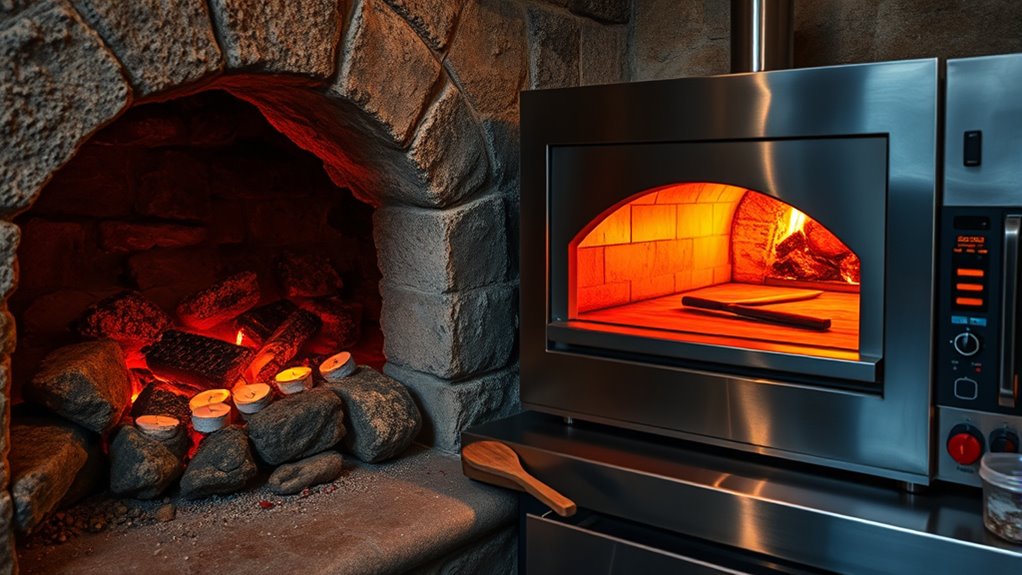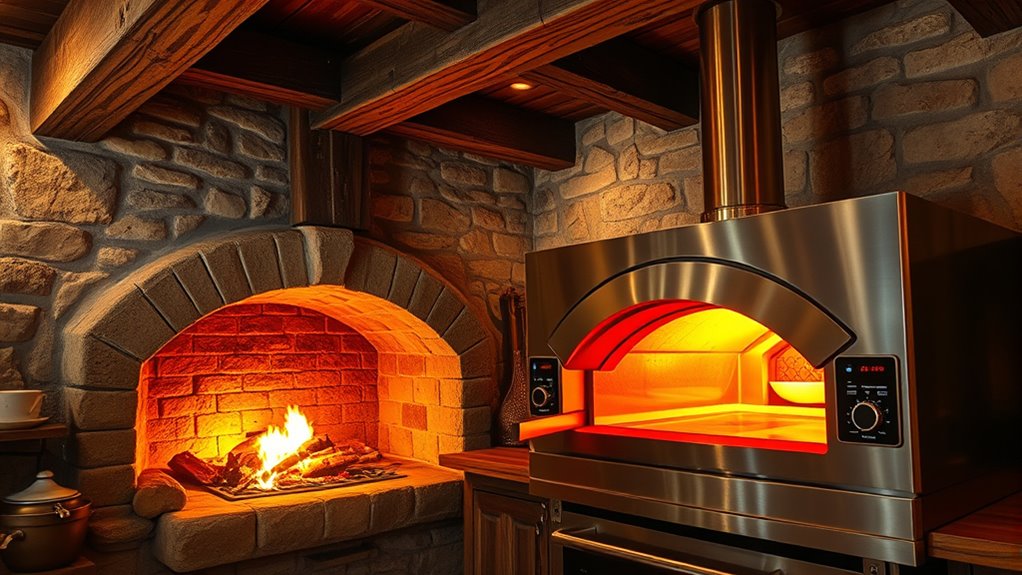Over the past 1,000 years, your kitchen has evolved from simple stone hearths used for roasting and boiling to advanced pizza ovens that provide precise heat control. Early fires laid the foundation for cooking, but innovations with brick, clay, and metal improved efficiency and safety. Modern ovens, incorporating technology and insulation, reflect centuries of progress. Discover how these changes turned basic fire pits into the sophisticated appliances shaping today’s culinary experiences.
Key Takeaways
- Early kitchens evolved from simple stone hearths to enclosed, specialized structures for better heat control and safety.
- Advancements in materials like clay, brick, and metal improved heat retention and cooking efficiency over centuries.
- Technological innovations introduced wood-fired, masonry, gas, and electric ovens, transforming baking and roasting methods.
- Modern pizza ovens incorporate advanced insulation and heat retention technologies, blending tradition with convenience.
- The culinary journey reflects societal progress, from basic open fires to sophisticated appliances enabling diverse cooking techniques.

Throughout history, kitchens have evolved dramatically, transforming from simple stone hearths into sophisticated appliances like modern pizza ovens. This journey reflects centuries of culinary evolution, where each innovation shaped how people prepare and enjoy food. In ancient times, cooking was a straightforward, communal activity centered around open fires or stone hearths. These early setups allowed for basic cooking methods— roasting, boiling, and baking— but offered limited control over temperature and cooking times. Despite these constraints, ancient cooking methods laid the foundation for culinary advancements by encouraging experimentation and adaptation. Early societies learned to harness fire’s power, developing techniques that improved flavor and safety, all while forging a deep connection between humans and their food.
As civilizations grew, so did their kitchens. Over centuries, the design of cooking spaces became more refined, integrating clay, brick, and eventually metal. This marked a significant step in the culinary evolution, allowing for better heat retention and more consistent cooking results. The introduction of enclosed hearths and early stoves provided greater control over temperature, which expanded culinary possibilities. During this period, cooking became more specialized, with tools and techniques evolving to suit local ingredients and tastes. This era also saw the birth of communal dining and the development of recipes that relied on techniques like baking bread, roasting meats, and boiling stews. These innovations transformed kitchens from simple fire pits into organized spaces where culinary artistry could flourish.
Moving forward, technological innovations continued to enhance the cooking experience. The invention of the wood-fired oven, the earliest form of the modern pizza oven, marked a significant milestone. These ovens allowed for high, consistent heat, enabling the perfect bake for bread and pizza. Over time, masonry ovens became popular, serving as focal points in homes and bakeries alike. The development of gas and electric ovens in the 19th and 20th centuries brought even greater precision and convenience, making sophisticated cooking accessible to more people. Today, modern pizza ovens—whether built into outdoor kitchens or integrated into appliances—are the culmination of centuries of culinary evolution. They combine tradition with technology, offering home chefs the ability to replicate ancient cooking techniques with modern ease, honoring the long history of how humans have transformed fire and heat into an art form. Additionally, innovations like modern heat retention and improved insulation have further enhanced the efficiency and effectiveness of these ovens.
Frequently Asked Questions
How Did Ancient Cultures Prepare Food Before Hearths?
Before hearths, you relied on fire pit innovations like open flames and simple pits for cooking. These methods were part of early cooking ritual origins, where you used heated stones, underground pits, or spit roasting to prepare food. Such techniques allowed you to cook meat and plants, making them safer and tastier, while also fostering communal gatherings around fire, marking a key step in culinary history.
What Materials Were Used for Early Cooking Vessels?
Imagine yourself holding a warm clay pot, its surface textured and earthy, or a shiny metal cookware gleaming in the firelight. Early cooks used clay potteries, crafted from natural clay, which could withstand the heat and absorb flavors. Metal cookware, made from bronze or iron, offered durability and heat conduction. These materials transformed cooking, allowing ancient cultures to prepare food more efficiently and develop rich culinary traditions.
How Did Cooking Techniques Evolve Alongside Kitchen Technology?
You see, cooking techniques evolved considerably as kitchen technology advanced. Fossil fuel adoption introduced gas stoves, making cooking faster and more controllable. Later, smart kitchen innovations brought automation and precision, transforming how you prepare food. These changes let you experiment more, save time, and improve efficiency. As technology progresses, your cooking methods become more sophisticated, blending traditional skills with modern tools for a better culinary experience.
Were There Regional Differences in Early Kitchen Designs?
You’ll notice that early kitchen designs showed clear regional differences, reflecting local cuisine and architectural styles. For example, Mediterranean kitchens often featured open layouts suited for communal dining, while Northern European ones prioritized warmth and insulation. These regional variations influenced layout choices, cooking methods, and tools, helping to shape distinct culinary traditions. So, your kitchen’s design often mirrors the regional cuisine and architectural influences of its area.
How Did Societal Changes Influence Kitchen Development?
You see, societal transformations and cultural impacts played a huge role in shaping kitchen development. As societies evolved, so did their needs and technologies, leading to more efficient and specialized kitchens. Changes like urbanization, social structures, and cultural preferences influenced kitchen layouts and appliances. You can see how these societal shifts drove innovations, making kitchens more functional and reflective of people’s lifestyles and cultural values over time.
Conclusion
Your kitchen journey is like a river flowing through time, constantly shaping and reshaping itself. From humble stone hearths to modern pizza ovens, each step reflects our ongoing passion for creating delicious food. Remember, every invention is a ripple in this never-ending stream of culinary history. So, next time you cook, think of yourself as part of this incredible story—carrying the flame forward, one meal at a time.









